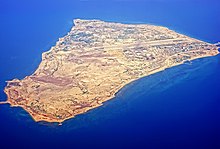Native name: جزیره سیری | |
|---|---|
 | |
| Geography | |
| Location | Persian Gulf |
| Coordinates | 25°54′34″N 54°32′22″E / 25.90944°N 54.53944°E |
| Area | 17.3 km2 (6.7 sq mi) |
| Length | 5.6 km (3.48 mi) |
| Width | 3 km (1.9 mi) |
| Highest elevation | 33 m (108 ft) |
| Administration | |
| Province | Hormozgan |
 | |
| Location | Sirri Island, Iran |
|---|---|
| Coordinates | 25°54′19″N 54°33′05″E / 25.905389°N 54.551361°E |
| Tower | |
| Foundation | concrete base |
| Construction | metal skeletal tower |
| Height | 20 m (66 ft) |
| Shape | square pyramidal skeletal tower[1][2] |
| Light | |
| Focal height | 30 m (98 ft) |
| Range | 10 nmi (19 km; 12 mi) |
| Characteristic | Fl(3) W 15s |

Sirri Island (Persian: جزیره سیری), is an island in the Persian Gulf belonging to Iran.
Sirri island (also known as Siri Island) is situated 76 kilometres (47 mi) from Bandar-e Lengeh and 50 kilometres (31 mi) west of Abu Musa island. Sirri is one of six islands in the Abu Musâ Island Group (and is part of Hormozgan province). The island is almost 5.6 kilometres (3.5 mi) long with a width of about 3 kilometres (1.9 mi). It covers an area of 17.33 square kilometres (6.7 square miles). The highest point on the island is 33 metres (108 feet) above sea level. Like the other islands in the Persian Gulf, it enjoys a warm and humid climate.
Sirri Island is the location of an oil platform that was once destroyed by the naval forces of the United States during Operation Praying Mantis on April 18, 1988. The platform was reconstructed later, after the war. The Sirri District includes the Sivand and Dena Oil Fields, Nosrat Oil Field, Alvand Oil Field and the Esfand Oil Field along with the Nasr offshore oil platforms. The airport located on the island (Sirri Airport (SXI)) is uncontrolled with a single 8,140-foot (2,480 m) runway though Iranian military planes have been seen there.
The Iranian Offshore Oil Company (IOOC) has undertaken several major oil and gas development projects on the island including a $500 million (USD) NGL Gas factory and a development contract to develop and increase production of the Iranian Nosrat oil field which is projected to increase crude oil production capacity from 5,000 to 16,000 barrels per day (790 to 2,540 cubic metres per day). Another project plans for the renovation of the crude oil export facilities and construction of two large crude oil storage tanks, each with 500,000 barrels (79,000 m3) capacity, on the island is also planned.[3]
- ^ Rowlett, Russ. "Lighthouses of Iran". The Lighthouse Directory. University of North Carolina at Chapel Hill. Retrieved 2016-10-03.
- ^ NGA List of Lights – Pub.112 Retrieved 3 October 2016
- ^ "Siri Island projects". IOOC. Archived from the original on 2010-08-13. Retrieved 2010-08-02.